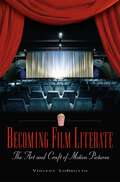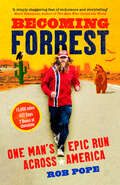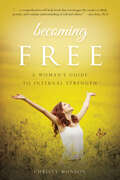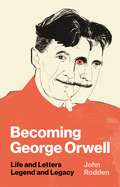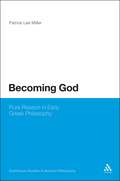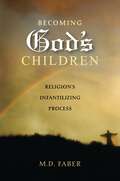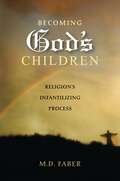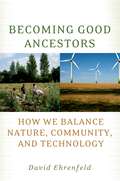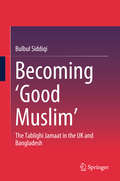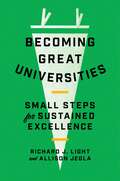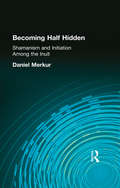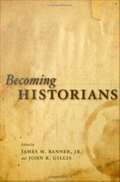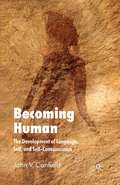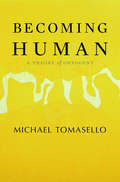- Table View
- List View
Becoming Film Literate: The Art and Craft of Motion Pictures (Non-ser.)
by Vincent LoBruttoThough movies have remained our foremost cultural pastime for over 100 years, many of us still know very little about the tools used to create them. In this groundbreaking new book, Vincent LoBrutto provides an enjoyable and accessible education in the art of cinema: using 50 landmark films spanning the history of the medium, LoBrutto illustrates such important concepts as editing, production design, cinematography, sound, screen acting, narrative structure, and various genres, nationalities, and film eras. Each concept is illustrated by the selection of a film that epitomizes its use, so that readers will learn about film authorship in Citizen Kane, multiplot narrative in Nashville, widescreen filmmaking in Rebel without a Cause, and screen violence in The Wild Bunch. Explaining the various tricks of the moviemaking trade, Becoming Film Literate offers a crash course in cinema, one designed to give even the novice reader a solid introduction to this complex and multifaceted medium.Though movies have remained our foremost cultural pastime for over 100 years, many of us still know very little about the tools used to create them. In this groundbreaking new book, Vincent LoBrutto provides an enjoyable and accessible education in the art of cinema: using 50 landmark films spanning the history of the medium, LoBrutto illustrates such important concepts as editing, production design, cinematography, sound, screen acting, narrative structure, and various genres, nationalities, and film eras. Each concept is illustrated by the selection of a film that epitomizes its use, so that readers will learn about film authorship in Citizen Kane, multiplot narrative in Nashville, widescreen filmmaking in Rebel without a Cause, and screen violence in The Wild Bunch.Providing a unique opportunity to become acquainted with important movies and the elements of their greatness, Becoming Film Literate offers a crash course in cinema, one designed to give even the novice reader a solid introduction to this complex and multifaceted medium.
Becoming Forrest: One Man's Epic Run Across America
by Rob PopeThe remarkable true story of an unrivalled journey to recreate the greatest run in film history: 15,621 miles, five-times across the United States.
Becoming Free: A Woman's Guide to Internal Strength
by Christy MonsonChristy Monson, a successful family therapist for over thirty years, has written Becoming Free to help you achieve your goals and find deeper happiness in your life. Becoming Free is a step-by-step book to help you to shed your armor, expand your optimistic thinking, and enhance your ability to give and receive. Once you become free of the armor you’ve built around you to protect yourself, you’ll find the abundant life you have always sought.
Becoming Free in the Cotton South
by Susan Eva O'DonovanBecoming Free in the Cotton South challenges our most basic ideas about slavery and freedom in America. Instead of seeing emancipation as the beginning or the ending of the story, as most histories do, Susan Eva O’Donovan explores the perilous transition between these two conditions, offering a unique vision of both the enormous changes and the profound continuities in black life before and after the Civil War. This boldly argued work focuses on a small place—the southwest corner of Georgia—in order to explicate a big question: how did black men and black women’s experiences in slavery shape their lives in freedom? The reality of slavery’s demise is harsh: in this land where cotton was king, the promise of Reconstruction passed quickly, even as radicalism crested and swept the rest of the South. Ultimately, the lives former slaves made for themselves were conditioned and often constrained by what they had endured in bondage. O’Donovan’s significant scholarship does not diminish the heroic efforts of black Americans to make their world anew; rather, it offers troubling but necessary insight into the astounding challenges they faced. Becoming Free in the Cotton South is a moving and intimate narrative, drawing upon a multiplicity of sources and individual stories to provide new understanding of the forces that shaped both slavery and freedom, and of the generation of African Americans who tackled the passage that lay between.
Becoming George Orwell: Life and Letters, Legend and Legacy
by John RoddenThe remarkable transformation of Orwell from journeyman writer to towering iconIs George Orwell the most influential writer who ever lived? Yes, according to John Rodden’s provocative book about the transformation of a man into a myth. Rodden does not argue that Orwell was the most distinguished man of letters of the last century, nor even the leading novelist of his generation, let alone the greatest imaginative writer of English prose fiction. Yet his influence since his death at midcentury is incomparable. No other writer has aroused so much controversy or contributed so many incessantly quoted words and phrases to our cultural lexicon, from “Big Brother” and “doublethink” to “thoughtcrime” and “Newspeak.” Becoming George Orwell is a pathbreaking tour de force that charts the astonishing passage of a litterateur into a legend.Rodden presents the author of Animal Farm and Nineteen Eighty-Four in a new light, exploring how the man and writer Orwell, born Eric Arthur Blair, came to be overshadowed by the spectral figure associated with nightmare visions of our possible futures. Rodden opens with a discussion of the life and letters, chronicling Orwell’s eccentricities and emotional struggles, followed by an assessment of his chief literary achievements. The second half of the book examines the legend and legacy of Orwell, whom Rodden calls “England’s Prose Laureate,” looking at everything from cyberwarfare to “fake news.” The closing chapters address both Orwell’s enduring relevance to burning contemporary issues and the multiple ironies of his popular reputation, showing how he and his work have become confused with the very dreads and diseases that he fought against throughout his life.
Becoming George Orwell: Life and Letters, Legend and Legacy
by John RoddenThe remarkable transformation of Orwell from journeyman writer to towering iconIs George Orwell the most influential writer who ever lived? Yes, according to John Rodden’s provocative book about the transformation of a man into a myth. Rodden does not argue that Orwell was the most distinguished man of letters of the last century, nor even the leading novelist of his generation, let alone the greatest imaginative writer of English prose fiction. Yet his influence since his death at midcentury is incomparable. No other writer has aroused so much controversy or contributed so many incessantly quoted words and phrases to our cultural lexicon, from “Big Brother” and “doublethink” to “thoughtcrime” and “Newspeak.” Becoming George Orwell is a pathbreaking tour de force that charts the astonishing passage of a litterateur into a legend.Rodden presents the author of Animal Farm and Nineteen Eighty-Four in a new light, exploring how the man and writer Orwell, born Eric Arthur Blair, came to be overshadowed by the spectral figure associated with nightmare visions of our possible futures. Rodden opens with a discussion of the life and letters, chronicling Orwell’s eccentricities and emotional struggles, followed by an assessment of his chief literary achievements. The second half of the book examines the legend and legacy of Orwell, whom Rodden calls “England’s Prose Laureate,” looking at everything from cyberwarfare to “fake news.” The closing chapters address both Orwell’s enduring relevance to burning contemporary issues and the multiple ironies of his popular reputation, showing how he and his work have become confused with the very dreads and diseases that he fought against throughout his life.
Becoming German: The 1709 Palatine Migration to New York
by Philip L. OtternessBecoming German tells the intriguing story of the largest and earliest mass movement of German-speaking immigrants to America. The so-called Palatine migration of 1709 began in the western part of the Holy Roman Empire, where perhaps as many as thirty thousand people left their homes, lured by rumors that Britain's Queen Anne would give them free passage overseas and land in America. They journeyed down the Rhine and eventually made their way to London, where they settled in refugee camps. The rumors of free passage and land proved false, but, in an attempt to clear the camps, the British government finally agreed to send about three thousand of the immigrants to New York in exchange for several years of labor. After their arrival, the Palatines refused to work as indentured servants and eventually settled in autonomous German communities near the Iroquois of central New York.Becoming German tracks the Palatines' travels from Germany to London to New York City and into the frontier areas of New York. Philip Otterness demonstrates that the Palatines cannot be viewed as a cohesive "German" group until after their arrival in America; indeed, they came from dozens of distinct principalities in the Holy Roman Empire. It was only in refusing to assimilate to British colonial culture—instead maintaining separate German-speaking communities and mixing on friendly terms with Native American neighbors—that the Palatines became German in America.
Becoming God: Pure Reason in Early Greek Philosophy (Continuum Studies in Ancient Philosophy)
by Patrick Lee MillerBecoming god was an ideal of many ancient Greek philosophers, as was the life of reason, which they equated with divinity. This book argues that their rival accounts of this equation depended on their divergent attitudes toward time. Affirming it, Heraclitus developed a paradoxical style of reasoning-chiasmus-that was the activity of his becoming god. Denying it as contradictory, Parmenides sought to purify thinking of all contradiction, offering eternity to those who would follow him. Plato did, fusing this pure style of reasoning-consistency-with a Pythagorean program of purification and divinization that would then influence philosophers from Aristotle to Kant. Those interested in Greek philosophical and religious thought will find fresh interpretations of its early figures, as well as a lucid presentation of the first and most influential attempts to link together divinity, rationality, and selfhood.
Becoming God's Children: Religion's Infantilizing Process
by M. D. FaberM. D. Faber presents a meticulous, unremitting inquiry into the psychological direction from which Christianity derives its power to attract and hold its followers.Becoming God's Children: Religion's Infantilizing Process was written, its author says, to alert readers to the role of infantilization in the Judeo-Christian tradition generally and in Christian rite and doctrine particularly. Because religion plays such an important role in so may lives, it is essential to understand the underlying appeal and significance of religious doctrines.To that end, Becoming God's Children offers the reader an in-depth account of human neuropsychological development, while unearthing the Judeo-Christian tradition's explicitly infantilizing doctrines and rites. This compelling perspective on the nature and meaning of religious behavior explores issues such as: to what extent religious faith is grounded in the mnemonic recesses of the worshipper's brain, whether believers are predisposed by both genetic makeup and environmental prompting to adhere to their religious convictions, and why some individuals are powerfully drawn to religious faith while others reject it. A final chapter explores the implications of religion's infantilizing process vis-a-vis the role of reason and scientific thought in the contemporary world.
Becoming God's Children: Religion's Infantilizing Process
by M. D. FaberM. D. Faber presents a meticulous, unremitting inquiry into the psychological direction from which Christianity derives its power to attract and hold its followers.Becoming God's Children: Religion's Infantilizing Process was written, its author says, to alert readers to the role of infantilization in the Judeo-Christian tradition generally and in Christian rite and doctrine particularly. Because religion plays such an important role in so may lives, it is essential to understand the underlying appeal and significance of religious doctrines.To that end, Becoming God's Children offers the reader an in-depth account of human neuropsychological development, while unearthing the Judeo-Christian tradition's explicitly infantilizing doctrines and rites. This compelling perspective on the nature and meaning of religious behavior explores issues such as: to what extent religious faith is grounded in the mnemonic recesses of the worshipper's brain, whether believers are predisposed by both genetic makeup and environmental prompting to adhere to their religious convictions, and why some individuals are powerfully drawn to religious faith while others reject it. A final chapter explores the implications of religion's infantilizing process vis-a-vis the role of reason and scientific thought in the contemporary world.
Becoming Good Ancestors: How We Balance Nature, Community, and Technology
by David EhrenfeldA brilliant writer and gifted "big picture" thinker, David Ehrenfeld is one of America's leading conservation biologists. Becoming Good Ancestors unites in a single, up-to-date framework pieces written over two decades, spanning politics, ecology, and culture, and illuminating the forces in modern society that thwart our efforts to solve today's hard questions about society and the environment. The book focuses on our present-day retreat from reality, our alienation from nature, our unthinking acceptance of new technology and rejection of the old, the loss of our ability to discriminate between events we can control and those we cannot, the denial of non-economic values, and the decline of local communities. If we are aware of what we are losing and why we are losing it, the author notes, all of these patterns are reversible. Through down-to-earth examples, ranging from a family canoe trip in the wilderness to the novels of Jane Austen to Chinese turtle and tiger farms, Ehrenfeld shows how we can use what we learn to move ourselves and our society towards a more stable, less frantic, and far more satisfying life, a life in which we are no longer compelled to damage ourselves and our environment, in which our children have a future, and in which fewer species are endangered and more rivers run clean. In the final chapter, he offers a dramatic view of the possibilities inherent in a fusion of the best elements of conservatism and liberalism. Our society has an inherent sense of what is right, says Ehrenfeld, and the creativity and persistence to make good things happen. It is now time to apply our intelligence, guided by our moral judgment, to the very large problems we all face. This book is an important first step.
Becoming ‘Good Muslim’: The Tablighi Jamaat in the UK and Bangladesh
by Bulbul SiddiqiThe book uses an ethnographic approach to explore why the Tablighi Jamaat movement remains so successful in contemporary times. It shows that this success results from the positive image that it cultivates, and the systematic preaching activities of Tablighi Jamaat followers, and that the organisation’s apolitical image, the public profile of the ijtema, the humbleness of Tablighi followers, and the attraction of belonging to the global Tablighi community all help to create a positive image of the Tablighi Jamaat among ordinary Muslims. The book also argues that the Tablighi Jamaat remains successful because of its ability to hold its followers within a Tablighi-guided life, which is perceived as protection against the Western lifestyle. Many elements of contemporary Western lifestyle are considered non-Islamic, and so by clearly defining what is Islamic and non-Islamic in modern society, the Tablighi Jamaat provides a way in which Muslims can live in the contemporary world, but remain good Muslims.
Becoming Great Universities: Small Steps for Sustained Excellence
by Richard J. Light Allison JeglaHow campus communities of every kind can transform themselves from good to greatBecoming Great Universities highlights ten core challenges that all colleges and universities face and offers practical steps that everyone on campus—from presidents to first-year undergraduates—can take to enhance student life and learning.This incisive book, written in a friendly and engaging style, draws on conversations with presidents, deans, and staff at hundreds of campuses across the country as well as scores of in-depth interviews with students and faculty. Providing suggestions that all members of a campus community can implement, Richard Light and Allison Jegla cover topics such as how to build a culture of innovation on campus, how to improve learning outcomes through experimentation, how to help students from under-resourced high schools succeed in college, and how to attract students from rural areas who may not be considering colleges far from their communities. They offer concrete ways to facilitate constructive interactions among students from different backgrounds, create opportunities for lifelong learning and engagement, and inspire students to think globally. And most of the ideas presented in this book can be implemented at little to no cost.Featuring a wealth of evidence-based examples, Becoming Great Universities offers actionable suggestions for everyone to have a positive impact on college life regardless of whether their campus is urban or rural, private or public, large or small, wealthy or not.
Becoming Habsburg: The Jews of Habsburg Bukovina, 1774-1918 (The Littman Library of Jewish Civilization)
by David RechterHabsburg Bukovina no longer exists, save in the realms of historiography, nostalgia, and collective memory. Remembered for its remarkable multinational, multi-faith character, Bukovina and its capital city Czernowitz have long been presented as exemplars of inter-ethnic co-operation, political moderation, and cultural dynamism, with Jews regarded as indispensable to the region’s character and vitality. This is not mere rhetoric: the Jews of Bukovina were integral to, and at home in, local society. David Rechter’s important new history conveys the special nature of Bukovina Jewry while embedding it in the broader historical and intellectual frameworks of Galician, imperial Austrian, and east central European Jewries. Carefully tracing the evolution of the tangled relationship of state and society with the Jews, from the Josephinian Enlightenment through absolutism to emancipation, he brings to light the untold story of the Jewish minority in the monarchy's easternmost province, often a byword for economic backwardness and cultural provincialism. Here, at the edge of the Habsburg monarchy, Jews forged a new society from familiar elements, a unique hybrid of eastern and western European Jewries. Bukovina Jewry was both and neither: understanding its history can help us grasp the east/west fault lines within European Jewry, a key element in the Jewish experience in Europe.
Becoming Half Hidden: Shamanism and Initiation Among the Inuit
by Daniel MerkurFirst Published in 1993. Routledge is an imprint of Taylor & Francis, an informa company.
Becoming Half Hidden: Shamanism and Initiation Among the Inuit
by Daniel MerkurFirst Published in 1993. Routledge is an imprint of Taylor & Francis, an informa company.
Becoming Hewlett Packard: Why Strategic Leadership Matters
by Robert A. Burgelman Webb McKinney Philip E. MezaBill Hewlett and Dave Packard invented the model of the Silicon Valley start-up and set in motion a process of corporate becoming that made it possible for HP to transform itself six times over the 77 years since its founding in the face of sweeping technological changes that felled most of its competitors over the years. Today, HP is in the throes of a seventh transformation to secure its continued survival by splitting in two independent companies: HP Inc. and Hewlett Packard Enterprise. Based on extensive primary research conducted over more than 15 years, this book documents the differential contribution of HP's successive CEOs in sustaining the company's integral process of becoming. It uses a comprehensive strategic leadership framework to examine and explain the role of the CEO: (1) defining and executing the key tasks of strategic leadership, and (2) developing four key elements of the company's strategic leadership capability. The study of the strategic leadership of HP's successive CEOs revealed the paradox of corporate becoming, the existential situation facing successive CEOs (that justifies the book's empathic approach), and the importance of the CEO's ability to harness the company's past while also driving its future. Building on these novel insights, the book shows how the frameworks used to conceptualize the tasks of strategic leadership and the development of strategic leadership capability can serve as steps toward a dynamic theory of strategic leadership that animates an evolutionary framework of corporate becoming. This framework will be helpful for further theory development about strategic leadership and also offers practical tools for founders of new companies and CEOs and boards of directors of existing companies who intend to create, run or oversee companies built for continued relevance, longevity and greatness.
Becoming Hewlett Packard: Why Strategic Leadership Matters
by Robert A. Burgelman Webb McKinney Philip E. MezaBill Hewlett and Dave Packard invented the model of the Silicon Valley start-up and set in motion a process of corporate becoming that made it possible for HP to transform itself six times over the 77 years since its founding in the face of sweeping technological changes that felled most of its competitors over the years. Today, HP is in the throes of a seventh transformation to secure its continued survival by splitting in two independent companies: HP Inc. and Hewlett Packard Enterprise. Based on extensive primary research conducted over more than 15 years, this book documents the differential contribution of HP's successive CEOs in sustaining the company's integral process of becoming. It uses a comprehensive strategic leadership framework to examine and explain the role of the CEO: (1) defining and executing the key tasks of strategic leadership, and (2) developing four key elements of the company's strategic leadership capability. The study of the strategic leadership of HP's successive CEOs revealed the paradox of corporate becoming, the existential situation facing successive CEOs (that justifies the book's empathic approach), and the importance of the CEO's ability to harness the company's past while also driving its future. Building on these novel insights, the book shows how the frameworks used to conceptualize the tasks of strategic leadership and the development of strategic leadership capability can serve as steps toward a dynamic theory of strategic leadership that animates an evolutionary framework of corporate becoming. This framework will be helpful for further theory development about strategic leadership and also offers practical tools for founders of new companies and CEOs and boards of directors of existing companies who intend to create, run or oversee companies built for continued relevance, longevity and greatness.
Becoming Hispanic-Serving Institutions: Opportunities for Colleges and Universities (Reforming Higher Education: Innovation and the Public Good)
by Gina Ann GarciaHispanic-Serving Institutions (HSIs);¢;‚¬;€?not-for-profit, degree-granting colleges and universities that enroll at least 25% or more Latinx students;¢;‚¬;€?are among the fastest-growing higher education segments in the United States. As of fall 2016, they represented 15% of all postsecondary institutions in the United States and enrolled 65% of all Latinx college students. As they increase in number, these questions bear consideration: What does it mean to serve Latinx students? What special needs does this student demographic have? And what opportunities and challenges develop when a college or university becomes an HSI? In Becoming Hispanic-Serving Institutions, Gina Ann Garcia explores how institutions are serving Latinx students, both through traditional and innovative approaches. Drawing on empirical data collected over two years at three HSIs, Garcia adopts a counternarrative approach to highlight the ways that HSIs are reframing what it means to serve Latinx college students. She questions the extent to which they have been successful in doing this while exploring how those institutions grapple with the tensions that emerge from confronting traditional standards and measures of success for postsecondary institutions. Laying out what it means for these three extremely different HSIs, Garcia also highlights the differences in the way each approaches its role in serving Latinxs. Incorporating the voices of faculty, staff, and students, Becoming Hispanic-Serving Institutions asserts that HSIs are undervalued, yet reveals that they serve an important role in the larger landscape of postsecondary institutions.
Becoming Hispanic-Serving Institutions: Opportunities for Colleges and Universities (Reforming Higher Education: Innovation and the Public Good)
by Gina Ann GarciaHispanic-Serving Institutions (HSIs);¢;‚¬;€?not-for-profit, degree-granting colleges and universities that enroll at least 25% or more Latinx students;¢;‚¬;€?are among the fastest-growing higher education segments in the United States. As of fall 2016, they represented 15% of all postsecondary institutions in the United States and enrolled 65% of all Latinx college students. As they increase in number, these questions bear consideration: What does it mean to serve Latinx students? What special needs does this student demographic have? And what opportunities and challenges develop when a college or university becomes an HSI? In Becoming Hispanic-Serving Institutions, Gina Ann Garcia explores how institutions are serving Latinx students, both through traditional and innovative approaches. Drawing on empirical data collected over two years at three HSIs, Garcia adopts a counternarrative approach to highlight the ways that HSIs are reframing what it means to serve Latinx college students. She questions the extent to which they have been successful in doing this while exploring how those institutions grapple with the tensions that emerge from confronting traditional standards and measures of success for postsecondary institutions. Laying out what it means for these three extremely different HSIs, Garcia also highlights the differences in the way each approaches its role in serving Latinxs. Incorporating the voices of faculty, staff, and students, Becoming Hispanic-Serving Institutions asserts that HSIs are undervalued, yet reveals that they serve an important role in the larger landscape of postsecondary institutions.
Becoming Historians
by James M. Banner John R. GillisIn this unique collection, the memoirs of eleven historians provide a fascinating portrait of a formative generation of scholars. Born around the time of World War II, these influential historians came of age just before the upheavals of the 1960s and ’70s and helped to transform both their discipline and the broader world of American higher education. The self-inventions they thoughtfully chronicle led, in many cases, to the invention of new fields—including women’s and gender history, social history, and public history—that cleared paths in the academy and made the study of the past more capacious and broadly relevant. In these stories—skillfully compiled and introduced by James Banner and John Gillis—aspiring historians will find inspiration and guidance, experienced scholars will see reflections of their own dilemmas and struggles, and all readers will discover a rare account of how today’s seasoned historians embarked on their intellectual journeys.
Becoming Historians
by James M. Banner John R. GillisIn this unique collection, the memoirs of eleven historians provide a fascinating portrait of a formative generation of scholars. Born around the time of World War II, these influential historians came of age just before the upheavals of the 1960s and ’70s and helped to transform both their discipline and the broader world of American higher education. The self-inventions they thoughtfully chronicle led, in many cases, to the invention of new fields—including women’s and gender history, social history, and public history—that cleared paths in the academy and made the study of the past more capacious and broadly relevant. In these stories—skillfully compiled and introduced by James Banner and John Gillis—aspiring historians will find inspiration and guidance, experienced scholars will see reflections of their own dilemmas and struggles, and all readers will discover a rare account of how today’s seasoned historians embarked on their intellectual journeys.
Becoming Historians
by James M. Banner John R. GillisIn this unique collection, the memoirs of eleven historians provide a fascinating portrait of a formative generation of scholars. Born around the time of World War II, these influential historians came of age just before the upheavals of the 1960s and ’70s and helped to transform both their discipline and the broader world of American higher education. The self-inventions they thoughtfully chronicle led, in many cases, to the invention of new fields—including women’s and gender history, social history, and public history—that cleared paths in the academy and made the study of the past more capacious and broadly relevant. In these stories—skillfully compiled and introduced by James Banner and John Gillis—aspiring historians will find inspiration and guidance, experienced scholars will see reflections of their own dilemmas and struggles, and all readers will discover a rare account of how today’s seasoned historians embarked on their intellectual journeys.
Becoming Human: The Development of Language, Self and Self-Consciousness
by J. CanfieldThis book is a philosophical examination of the stages in our journey from hominid to human. Dealing with the nature and origin of language, self-consciousness, and the religious ideal of a return to Eden, it has a philosophical anthropology approach. It provides an account of our place in nature consistent with both empiricism and mysticism.
Becoming Human: A Theory of Ontogeny
by Michael TomaselloVirtually all theories of how humans have become a distinctive species focus on evolution. Here, Michael Tomasello proposes a complementary theory focused on ontogenetic processes. Built on the essential ideas of Vygotsky, his data-driven model explains how those things that make us most human are constructed during the first six years of life.
